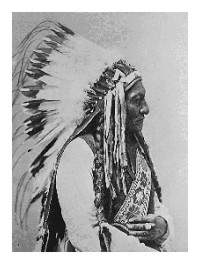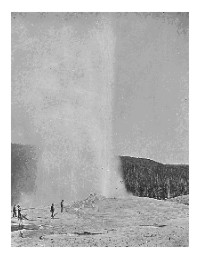
Photo above: President U.S. Grant. Courtesy National Archives. Right: Valley of the Yellowstone, 1871, by William Henry Jackson, Hayden Survey. Courtesy Library of Congress.

U.S. Timeline - The 1870s
The Centennial Decade. Madison Square Garden History Begins.
-
1874 Detail
-
To the 1880s
Click here to Sponsor the page and how to reserve your ad.
-
Timeline
1874 - Detail
July 1, 1874 - First commercially successful typewriter, the Sholes and Glidden typewriter, or Remington No. 1, is placed on the market.

Yes, we're one hundred and fifty years or so after this date, and although it is somewhat forgotten over the last twenty years with the developments in technology that made the typewriter itself obsolete, there's nothing obsolete about QWERTY and the keyboard that was first developed on that first commercially successful typewriter developed and sold by Sholes, Soule, Glidden, Densmore, and Remington. It is the basis for every keyboard, whether on your desktop computer, laptop, or cell phone.
So who were these men and how did this revolutionary piece of equipment come to market?
First there's Christopher Latham Soles. Born in 1819 in Montour County, Pennsylvania, Soles moved to Wisconsin at the age of eighteen and became a newspaper publisher and politician. Although there had been various typewriters invented before, i.e. since Henry Mill (1714), William Burt (1829), and others, none had been particularly successful in the commercial marketplace. At first, Soles began thinking about an invention for typesetting, but this proved unsuccessful. Working with Samuel Soule, they turned their attention to a numbering machine and patented one in 1866.
They showed their machine to Carlos Glidden, a lawyer and inventor, who theorized that adding letters to the contraption might be an interesting turn.
"Sholes, why cannot you build a machine to print letters and words as
perfectly as these figures are struck off here?" exclaimed Glidden.
With inspiration from a machine that John Pratt had been working on, but they thought too complex, the three men formed a partnership to come up with a prototype machine, the typewriting machine. Soles, Soule, and Glidden would patent their first attempt, the "literary piano," on June 23, 1868. Needing money, they sold one quarter of that patent to James Densmore for $600, who thought the current design was poor. At this time, Soule and Glidden left the project.
Using stenographers to test the machine's designs, improvements were made through 1873, when Sholes made a drastic change. The QWERTY keyboard was developed, but not for its sensible collection of keystroke placement, but because the platen needed time to go up and down between strokes of the most used letter combinations. Those combinations were thereafter placed far apart.
By 1873, the partnership had approached a large manufacturer, E. Remington and Sons, who thought the idea interesting, and wanting to diversify their portfolio after the end of the Civil War from their firearms business established in 1816, made an offer. Soles was bought out for $12,000. Remington made a royalty deal with Densmore. That proved the better option. Over the next decades, Densmore would make $1.5 million in royalites once Remington began marketing the new typewriter on July 1, 1874.
Oddities of the first Sholes keyboard
There was no number 1. Sholes thought the typist could get by using the letter l. There also was no shift key, so all letters were capital. Shift keyboards were introduced in 1878. And what were the reasons for the other letters on the top row. Well, they had to spell the word "Typewriter" so salesmen could demonstrate the prototypes as fast as possible. For the first years of its use, the Hunt and Peck method was standard. It was not until 1888 when a law clerk in a typing competition, Frank E. McGurrin, won using the touch typing method.
Success of the Remington Typewriter
From March 1, 1873, Remington began to produce one thousand machines at their Ilion, New York factory in a dedicated wing; they had the option to produce twenty-four thousand more. Once the machines had been retooled and production actually started in September, a new marketing firm established by Densmore, and partner George W. N. Yost, with exclusive sales rights, were ready to go to market by July 1, 1874.
The cost of one machine was $125; at first they sold poorly, only four hundred by December. E. Remington promoted their new products heavily and made constant improvements. Both the Remington typewriter and Remington sewing machine were lauded at the Philadelphia Centennial Exhibition of 1876. By 1877, four thousand machines had been sold, with the introduction of Remington #2 in 1878, now with upper and lower case letters, adding to the total. Estimates of the sales of the Sholes and Glidden model, Remington #1, are five thousand.
Although it's often noted that the Remington typewriter, with its similarity in design to a sewing machine, was not as popular at the Centennial as Bell's telephone, Bell's telephone was not the hit of the fair either. That would go to the Corliss Steam Engine, the arm of the Statue of Liberty, or many other inventions that marveled the world. The world saw multiple language typewriters by Remington later; they were introduced in 1893.
Image above: Montage of Christopher Latham Sholes and the Sholes and Glidden typewriting machine, 1912, George Iles. Courtesy "Leading American Inventors," George Iles via Wikipedia Commons. Image below: Montage of the Remington #1, 1922, Clarence Charles Smith, and the Remington Factory in 1874, 1874, Leon Case. Courtesy Wikipedia Commons. Info Source: mit.edu; "Circa 1874 AD, The Sholes (QWERTY) Keyboard"; "Party Like It's 1876! 12 Items From the Centennial Exposition," 2010, Scott Allen, Mentalfloss.com; "Leading American Inventors," 1912, George Iles; Wikipedia Commons.






